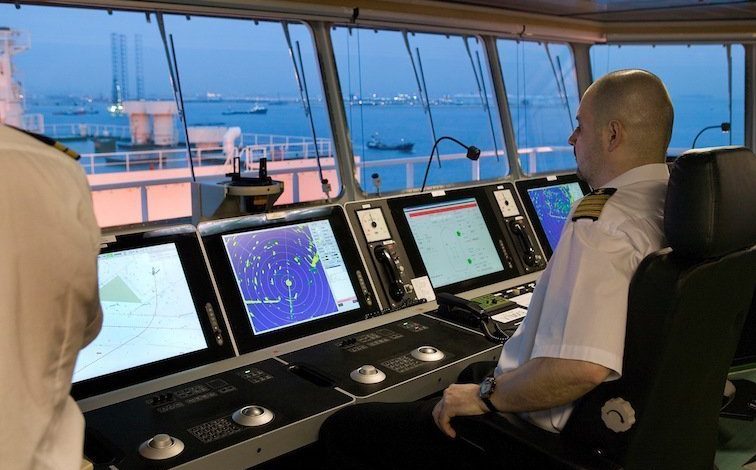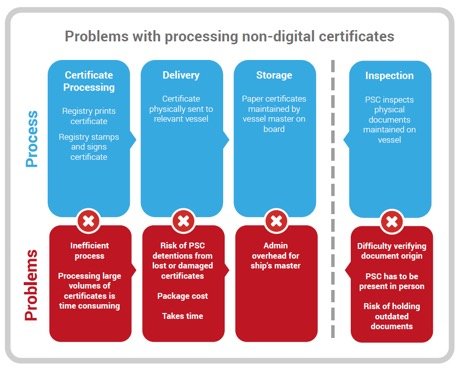Why the maritime industry must embrace e-certificates

Highlights from a recent white paper prepared by software firm PDMS.
As a result of ongoing commercial challenges in the maritime industry, organisations are turning to technological innovation to reduce costs and gain competitive advantage. However, some of the more intriguing aspects of the maritime technology the interlinked possibilities around electronic certification (e-certification) and their online verification (e-verification).
As a software development company, e-certification and online verification of certificates are increasingly topics of conversation with our maritime contacts and clients. However, despite the obvious benefits of e- certification we are discovering that digitisation is not being embraced quickly.
Trouble with paper certificates
Typically, the process for issuing paper certificates involves a number of inefficiencies:
- Manual processes: printing, stamping and posting are inefficient and costly.
- Certificate loss: certificates can be lost and damaged during postage
- Administrative burden: paper certificates contribute to the administrative burden placed upon ships’ masters, PSC and ship registries.
- Security issues: identification of an ‘original’ is challenging and onerous, with exposure to forgery.
The diagram below uses endorsements as an example of how paper certificates involves a number of issues:

The fact is that paper certificates are inherently insecure and certificate fraud is a well-documented issue, particularly for Certificates of Competence (CoC). However, new 2017 IMO regulations focus the need to deal now with the absence of online verification capabilities across the industry.
Does regulation support electronic certificates/documents?
The Facilitation Committee’s 40th session (April 2016 – FAL 40) recommended changing the IMO Procedures for PSC so that e-certificates are considered equivalent to paper certificates. This is a step change and means that when ship owners, flag states, Recognised Organisations etc. use e-certificates, PSC officials could be viewing them without needing a printed copy.
Safeguards put in place at FAL 40 are also intended to help deal with the real-world issue that in some regions the electronic version is still routinely questioned. The guidelines stipulate that ‘e-certificates’ must include a unique tracking number and also be protected from modifications, which are both capabilities that the IT world is already very familiar with.
This has been qualified by Roger Butturini, Chair of the ‘Working Group on Electronic Means for the Clearance of Ships of the FAL Committee’. Roger explained to us that:
“FAL’s main goal in developing the FAL40 Circular was to remove barriers to the use of electronic certificates. We fairly quickly determined that the challenge to using electronic certificates was not a technological one, but a policy decision predicated on acceptance by Port State Control Officials. Otherwise, the advantages of electronic certificates are unquestionably preferred to paper certificates.”
How technology can address issues
Within PDMS Maritime’s MARIS ship registries platform we are launching new functionality which includes generating electronic signatures and unique tracking numbers for certificates.
The issue of ensuring a document hasn’t been modified since being issued are both dealt with by digitally signing the document with what is termed a security-certificate. These security-certificates are issued by global authorities that certify the validity of the certificate and any documents signed using it.
The ‘security-certificate’ is electronic data issued and held by an accredited certificate authority. This can be thought of as keys used to encrypt and decrypt an electronic document. In each case, there are two keys. The first is used by the platform to encrypt and create the digital signature of a document. The second is is used by an eDocument reader to decrypt the digital signature which consequently validates the contents and origin of the document.
Once a signature is created it can only be read by using the public key. The origin of the public key can be verified with the certificate authority ensuring the signature was generated by the private key that was issued to the ship registry, or creator. So, once digitally signed, documents are truly ‘read only’ and cannot be modified.
Benefits of e-certification
E-certification and e-verification will significantly reduce the administrative burden placed upon ship’s masters and all stakeholders, as well as eliminating the need to courier certificates, or e-mail unsecured attachments all around the world. Continuing with the example of endorsements, the benefits are summarised in the diagram below:

Online verification will enable stakeholders to type in the document tracking code and receive an instant digital authentication. This significantly reduces the amount of time spent manually requesting verifications of a certificate or document.
Barriers to uptake
From a technology perspective, enabling the solutions for true e-certification and online verification are achievable, however the challenges of engagement, acceptance and business change represent the greater hurdles.
